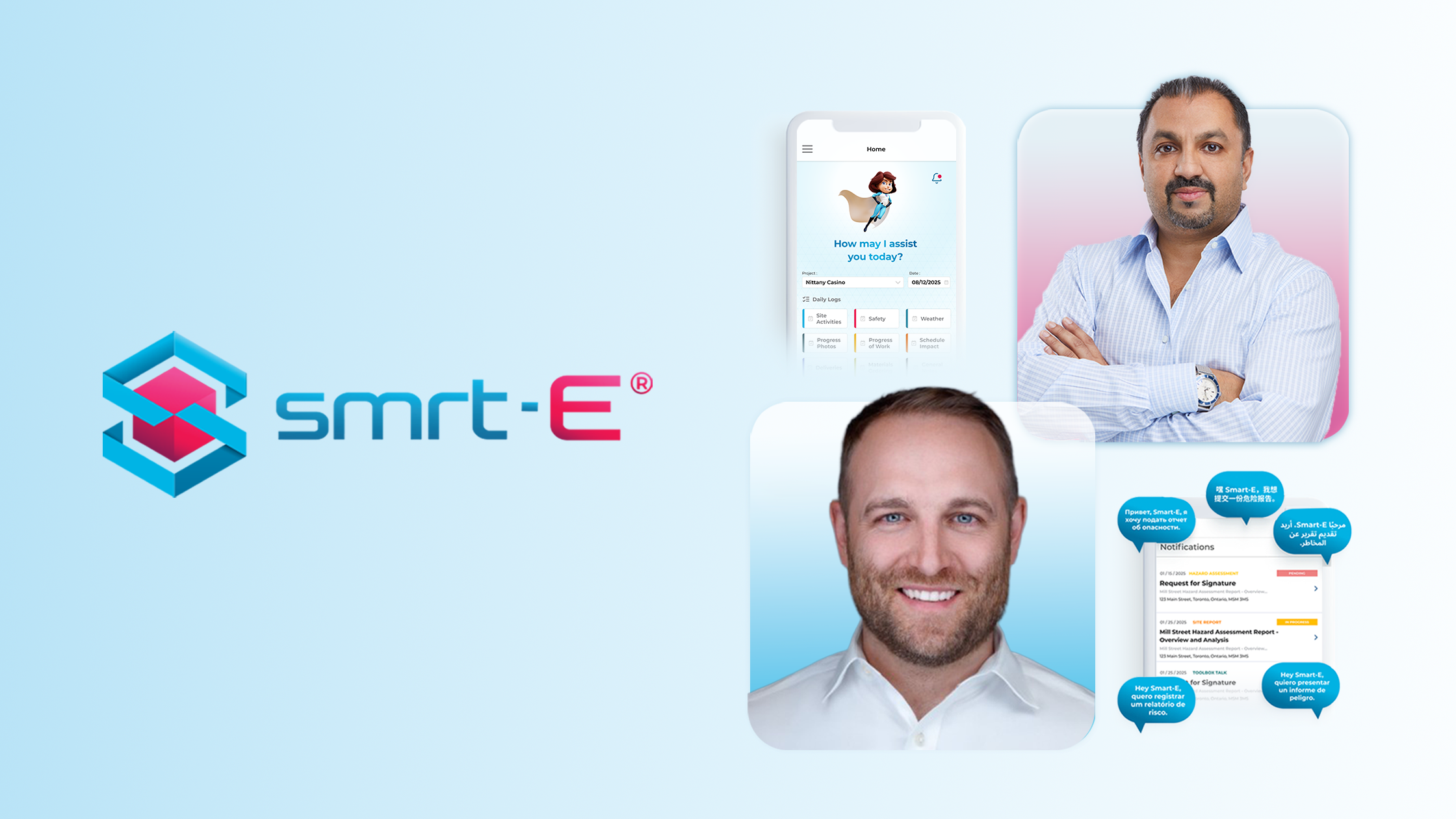Under the Hard Hat sat down with Rowan Steel-Hall, Chief Operating Officer at SMARTBUILD, to talk about smrt-E, the company’s intelligent voice-based construction assistant. From eliminating paperwork friction to reimagining how field teams communicate, Rowan walks us through the journey behind smrt-E and why it could be the next essential tool on every job site.
This article has been edited for clarity and conciseness. If you want to learn the full story behind smrt-E’s construction Ai assistant and how it works, check out the full episode on our YouTube channel: https://youtu.be/cP4H39a_cac
—
UTHH: Let’s start with the big picture. What inspired the creation of smrt-E, and how does it connect to SMARTBUILD’s larger mission?
Rowan Steel-Hall: smrt-E is really exciting for us. What I’m passionate about is getting technology into the hands of real people. When Zulq (Zulq Malik, SMARTBUILD’s Founder) and I first spoke about creating a voice-based agent specifically for construction, it just clicked. There are a lot of tools out there, like Siri or ChatGPT, but they aren’t built to help people on job sites fill out safety forms or daily logs. smrt-E is.
UTHH: Was there a specific moment or problem that made you say, “We need to do this better”?
RSH: Absolutely. It came from Zulq’s experience, he’s got over 30 years in the field, and from my own frustration with paperwork in previous roles. I’ve worked with restaurant teams and field teams in manufacturing, and no one likes filling out forms. If I could just talk to an agent that knows how to ask me the right questions, that would be a win. As a parent, even filling out field trip waivers can feel like a chore. Imagine doing that while wearing gloves and a hard hat.
UTHH: smrt-E fits into SMARTBUILD’s goal of “taking the stress out of technology while shaping the world.” Would you agree?
RSH: Absolutely. Anything we can do to remove friction in building and creating is a win for the industry.
UTHH: Who did you design it for first? Field teams, project managers, executive teams?
RSH: Initially, it was the field worker. That’s where the lightbulb moment happened. I wanted to help teams communicate in the language they use with their families, not force them into English if that’s not their first language. If someone is most fluent in Spanish, Polish, or Portuguese, I want them to speak to smrt-E in that language and let the system do the translation. It cuts confusion and increases accuracy.
UTHH: What feature do you think users are most excited about right now?
RSH: The speed. People speak at roughly 150 words per minute, but type into their phones at only about 15. A report that would take 30 minutes to type out can be spoken in two or three minutes. But it’s not just about speed, it’s about richness. When you’re not fighting with a tiny keyboard, you give more details. Better reporting leads to better decisions upstream.
UTHH: How does smrt-E integrate with other tools like Procore or Autodesk?
RSH: We designed it to be platform-agnostic. It works well within SMARTBUILD, but also integrates with tools like Procore and Autodesk. We even ran a session recently where a customer submitted field reports through smrt-E and had them appear in Procore in real time. That’s where we’re going; making it easy for users regardless of their existing platform.
“It should feel like Google Maps for your paperwork” states Rowan Steel-Hall, COO of SMARTBUILD. If you’re looking to test out how it works, you can sign up for a demo using this link: https://smrte.ai/#contact
UTHH: I’ve read smrt-E can help with litigation support. Can you explain that in simple terms?
RSH: Sure. First, smrt-E keeps the original language of record. So if someone speaks in Spanish and it’s translated into English, we keep both versions. That way, there’s no ambiguity in what was said. Second, we’re working on features like delay notifications tied to weather events. Imagine a frost delay in Texas; you report it by voice, and smrt-E cross-references the weather data, your location, and your contract, then drafts a notification email. It’s like having a legal clerk on retainer.
UTHH: How did you train the AI to understand the construction environment?
RSH: That’s thanks to the deep industry experience on our team. Zulq, Cash, and others have decades in construction. We’re working closely with clients in our beta phase, customizing smrt-E based on what they actually need. For example, we learned that daily reports are often updated throughout the day, not filled out all at once. So we’re rebuilding that flow to reflect how people really work.
UTHH: What kinds of ROI are companies seeing after adopting smrt-E?
RSH: It’s early, so we don’t have hard numbers on disputes or litigation, but time savings alone are huge. A single user might save 10 to 15 minutes per report. If someone earns $100 an hour, that adds up quickly. At about $20 a month per user, it pays for itself fast. And we’ve priced it intentionally for accessibility; we don’t want this to be a premium tool that only a few get to use.
UTHH: How have field teams responded to it? Especially those who aren’t necessarily tech-savvy?
RSH: Very well. Once someone gets signed in, it only takes about 20 minutes to learn. The biggest barrier is usually the login. After that, people find it intuitive. Honestly, they don’t care whether it’s AI or not, they just want something that makes their day easier.
UTHH: Where do you see smrt-E going in the next year or two?
RSH: We’re focused on integrations; Autodesk, Procore, Oracle, Trimble. And once we have enough data, we’ll be able to start generating insights. But to do that, we need strong foundational data first. That’s a big issue in construction right now. AI tools can be amazing, but without good data, they’ve got nothing to work with. So we’re solving the data problem first.
UTHH: If someone was on the fence about trying smrt-E, what would you say?
RSH: I’d say this is a convenience tool. It’s here to make your life smoother. If I can help you finish your workday a little earlier so you can make it to dinner or pick up your kids, that’s a win.
UTHH: What do you hope every user feels the first time they use smrt-E?
RSH: That it just works. Great products, especially AI products, should feel invisible. You forget what life was like without them. Like Google Maps. You use it because it works, it’s reliable, and it saves you brainpower. That’s what I want smrt-E to feel like.
UTHH: Anything else you’d like our readers to know?
RSH: Even if you don’t use a system right now, if you’re still on paper, we’ve got you covered. We’re adding functionality to help companies with zero systems onboard gradually. I’m especially excited about QR-code equipment checklists. Imagine scanning a QR code on a vehicle and being walked through your inspection by voice. That replaces logbooks and helps avoid delays. In one real case, a missing logbook delayed crane usage by three days. Avoiding that kind of issue just once could pay for the entire program for a year.
If you’re interested in checking out how smrt-E works, sign up for a demo using this link: https://smrte.ai/#contact
Want more insights on innovations like this? Subscribe to our newsletter for interviews, industry innovations, and stories from the field you won’t find anywhere else.


